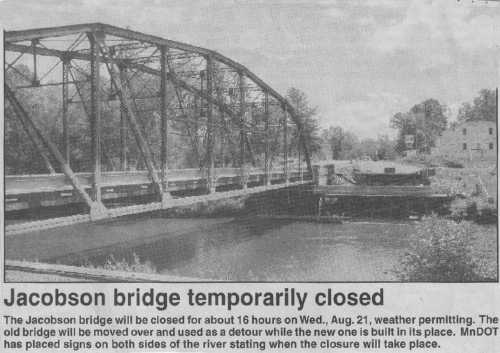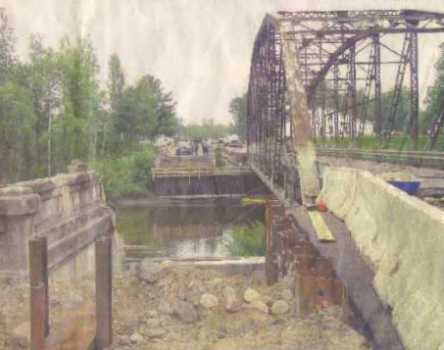Sandy Lake $1.00
F.M. Oaks $1.15
Wm. Wiggins $1.21
Verdon-E.B. Wells $1.30
Lloyd Wells $1.31
J.P. Riggs $1.35
John Sornberger $1.45
John Nordberg $1.48
John Lofgren $1.50
Ball Bluff $1.55
A.B. Feero $1.60
Miss. Landing $1.75
S.D. Wilson $1.90
Pete Torry $2.00
Spithand $2.10
Grand Rapids $2.40
(Per "THE EARLY DAYS OF JACOBSON AND HILL CITY" by Carl W. Boese)
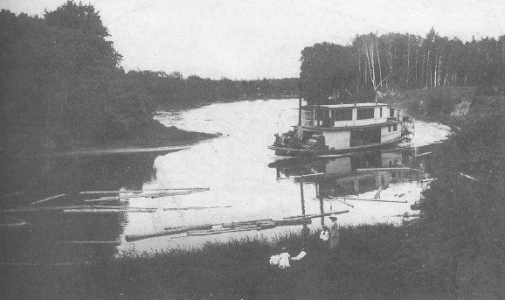
1914 THE STEAMBOAT LEE ON THE MISSISSIPPI RIVER
Courtesy Walter Koski
Besides these major stops, there were up to 79 various stops at farmsteads along the way. Meals on the steamboat were 25 cents and lodging was 50 cents. The boats used cord wood which was contracted for $2.50 a cord. When landed on the riverbank, the passengers would line up, and the wood would be passed from one person to the next for loading.
In later years, Harry Riggs ran a motor boat from Verdon to Mississippi Landing hauling passengers, mail, and freight.
The main benefactors of Mississippi Landing were two loggers, Ammi Wright and Charles Davis. They recognized the location as an excellent spot to build a base camp for their logging operations and as a terminus for their logging railroad. They saw that piers could be built, and logs could be dumped into the Mississippi River where they could then be sent down to the lower river sawmills. Much of the easy to get at timber had already been cut by 1890. The previous loggers had cut all the pine near to the rivers and now it was much more difficult to get at the timber. Many of the loggers had about given up as the timber in the Gardner area and on the range were not near enough to water to make it economical to skid and sluice to the far off streams and rivers.
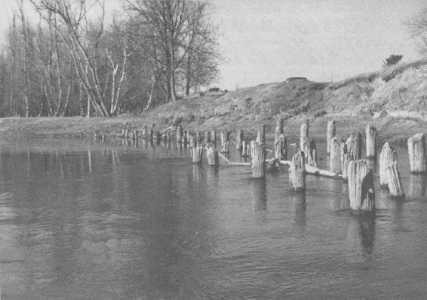
REMAINS OF THE LOG LANDING PIER AT MISSISSIPPI LANDING
Leo Trunt Collection
Wright and Davis solved that problem by constructing a logging railroad from the confluence of the Swan and Mississippi Rivers up into the high elevation timberlands of the Gardner and Hibbing areas in 1892. From this railroad they were able to spin off spurs to the various stands of timber. All of the logs were then sent down to the various piers built along the river at Mississippi Landing and then dumped off the cars and into the river. The activity at the landing was busy, and the logs were unloaded at a hectic pace. "Wright and Davis have cleared up all track landings along the line of the Swan River Logging Railway, and have broken the landings into the lakes. From now on during the season they will be hauling by rail to the Mississippi River at the rate of about 500,000 feet per day." (Hibbing Sentinel ~ May 21, 1898)

DULUTH, MISSISSIPPI RIVER, AND NORTHERN RAILROAD TRAIN
Courtesy Northeast Minn. Historical Center, Univ. of Minn., Duluth
The Swan River Logging Company's base or support camp at Mississippi Landing was, in fact, a full blown village of no small means. "The Duluth, Mississippi River, & Northern, Railroad is making extensive improvements at their headquarters at the mouth of Swan River. An extensive machine and repair shop has been built, as well as an 8 stall engine house." (Grand Rapids Magnet ~ Oct. 30, 1984) It was a company town and was equipped with every convenience and necessity of the times. At this site were an office, general manager's house, ice house, boarding house, railroad boarding house, turntable, roundhouse, machine shop, car shop, casting house, harness room, cattle barn, hog pen, sawmill, several warehouses, coal bins, roothouse, store, school house, coal dock, pumping house, water tank, boathouse, sand house, and several cottages. (Per Diagram of Headquarters of Swan River Logging Co., dated Nov. 26, 1901 ~ courtesy Itasca County Historical Society)
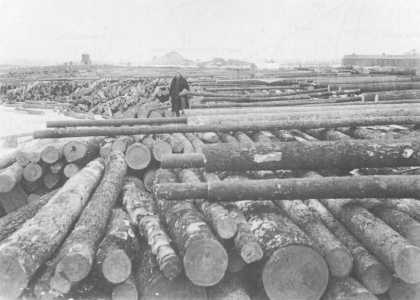
1895 SWAN RIVER LOGGING COMPANY HEADQUARTERS AT MISSISSIPPI LANDING
Headquarter buildings in the background
Courtesy Ed and Vera Simons

JACOBSON: MISSISSIPPI RIVER LOG LANDING
Logs ready for break up and drive
Courtesy Itasca County Historical Society
(Is that a woman wielding the cant-hook on the right?)
Much of the supplies and materials for the headquarters camp were brought from Duluth over the Duluth & Winnipeg Railroad to Swan River and then down the Wright and Davis Railroad to Mississippi Landing. Even so, some material and equipment used for constructing the railroad and camp came by riverboat and was landed on the river bank. "A pile driver and sawmill outfit arrived on last evening's train from Meredith, Mich. Today a crew is engaged in unloading and transferring it to the steamer Fawn for conveyance to the mouth of Swan River, where it will be placed in running order and used in getting out the necessary dimension stuff for the Mississippi River & Northern Railroad, ~ the Wright & Davis Logging Railway." (LaPrairie News ~ June 23, 1892)
The Wright and Davis people built their line with all the modern equipment. It was a first class operation. One of the methods they used for improved communication was to install telegraph lines connecting the various stops along their line. "The D.M.R.&N. telephone is now complete and connects Hibbing, Penobscot, Mahoning, Leighton, Swan River, and Mississippi." (Hibbing Sentinel ~ May 21, 1898)
The main foreman for the Swan River Logging Company camp at Mississippi Landing was Tom Murphy. Murphy was not above taking a few liberties with the company trains at times. "Murphy would tell us stories about how they would fire up the old # 1 engine and go to Swan River to get a bottle and then come back to the landing and drink it." (Per interview with Robert Lundin on 1/22/1990) Murphy had a large farm setup at the landing, where they raised food for the logging camps. It wasn't the total supply for the hungry jacks, but the farm did go a ways to hold down the amount of purchased foodstuffs. At the Mississippi farm, about 2 car loads of potatoes, carrots and assorted vegetables were raised in an average year.
After the winter season, the logging horses were brought back down to the landing where they were kept during the summer months. Some of the horses were so badly crippled from the rough winter work that they had to be destroyed, and a horse graveyard was established near the junction of Highways 65 and 200. "They have hauled 15 dead horses into the limits of the town site and left them there to become a nuisance and taint the otherwise pure atmosphere, contrary to the laws made and provided." (Aitkin Age ~ July 16, 1901)
Accidents while logging were quite common and at times even fatal. Many of the loggers were brought to Grand Rapids or at times buried on the spot. A cemetery was set up north of the landing where loggers were buried. It is said that seven men were buried there throughout the years. The Swan River Logging Company even built a board fence around the cemetery. (Per interview with Robert Lundin on 1/22/1990)
Speculators felt that they were being locked out of a chance to make money from the new economic activity. So on January 31, 1894, John and Mary Moak, W.E. Perrin, and Agnes and K.K. McLeod platted the town site of Hiawatha. It was hoped that a competing village would grow alongside Mississippi Landing. This was not to be because the railroad wouldn't allow any freight, mail or any other business to reach the new plat. "The growth of this village is as sure as anything on the earth, notwithstanding the hostility of the management by J.J. Hill's tools that are doing everything in their power to discourage settlers and hinder transportation. The company owns the land around the terminus of the railroad and will not sell any lots to any person for any purpose whatever, and they have put a fence across the county road 80 rods south of their shops, and east until it reaches the center of the west street of Hiawatha, then followed the middle of the street 1/4 of a mile north of the town site, effectually cutting the residents of the town off from both railroad and steamboat landings. People living on the town site have to go down the Mississippi River a distance of two miles to connect with the steamboat. They have turned about 200 horses loose on the town site, which are running at will and destroying everything they can get at. If the people protest against such treatment, they are boycotted at the company's store, and refused all the necessities of life, even when cash is tendered." (Aitkin Age ~ July 16, 1901)
Paul Jacobson started the local post office in 1901. The lumber company wouldn't allow him on their land, so he bought a lot at Hiawatha. It was the only lot that sold at Hiawatha. Because of the action of the railroad, he later lost out, and the post office was taken over by Robert Greenwood in 1913. (Per Postmaster records ~ U.S.National Archives)
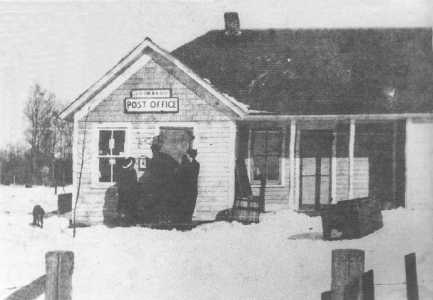
1916 GREENWOOD POST OFFICE AT HIAWATHA
Courtesy Itasca County Historical Society
The name Jacobson, however, seemed to stick. More and more of the people now called the area by that name. Paul Jacobson went on to operate a small general store of sorts until about 1908. He then bought a farm where the present-day state gravel pit is on Highway 200. Paul Jacobson raised and sold potatoes, hired out for labor, and was the local notary public and justice of the peace. (Per Paul Jacobson General Store and Person Record Book ~ 1946)

JACOBSON ADVERTISEMENT
Courtesy Carmen Loberg
In 1908, the Great Northern leased the tracks from Swan River to Mississippi Landing to the Hill City Railroad. The new railroad was called the Mississippi, Hill City, & Western Railway. Great excitement stirred the countryside as the new venture got underway. "Work on the rail which is being built into Hill City is progressing nicely. Piling for a bridge across the Mississippi at Mississippi Landing where the road will join the spur of the Swan River Logging Company is driven, and the engineers have been working on the line for some time past, so that the line will be ready very shortly for the commencement of the clearing and grading of the right of way...J. and R. W. Rosholt, wealthy bankers and manufacturers who are heavily interested in that section, and who will put in a hardwood factory like the one now being built at Cohasset, volunteered, after looking into the matter, to put up half the cost of such a road as is proposed if the balance could be raised by subscriptions being paid for in preferred stock in the railroad company. . . . The road, it is estimated, will cost about $100,000. The company will use Great Northern rolling stock." (Itasca County Independent ~ April 2, 1908)
A trestle was built over the Mississippi in 1908 when the Hill City Line was constructed. The trestle had a "swing" bridge in the river which could be turned to allow steam boats to pass by. A ferry was used for a number of years on the downstream side of the trestle. (See THE RABEY LINE by Robert Lemen) Once across travelers could then reach points in Itasca County.
The railroads and steamboats were not always used for just work. Occasionally they were used for the pleasure of the local people. A reporter notes the fun they all had one Sunday in 1910. "About five o'clock Sunday morning, there was a great blowing of whistles in Hill City. It was the first signal to the people that the excursion to Sandy Lake was getting ready to start. Merry crowds began to gather at the depot soon after the first warning was given and shortly after six, the excursion train was ready to pull out. There were one hundred passengers from Hill City and about fifty came from Swan River. The boat left the Mississippi at seven-thirty and the run down the River to beautiful Sandy Lake was made in four hours. At Sandy Lake, the crowd had a picnic dinner and put in the afternoon just enjoying life. The Hill City Band was on hand to add life to things and the weather man stood in with the crowd and dished out generous measures of the most ideal weather and all together the time passed right merrily until four o'clock, when the trip back up the river was commenced. Of course, the center of attraction was the ball game between the Gophers and the Swan River Selects, which was won by the latter by a score of 11 to 7. The trip up the river was probably the best part of the day. The Oriole swung slow up stream with band playing. Slowly the sun sank to rest and the shadows deepened, the darkness crept up until the silent night descended swiftly upon the land and the water. A soft glow in the east heralded the rising moon, and--Oh piffle, the boat whistled for Mississippi Landing and everybody woke up and boarded the train for home. There were some tired people in the metropolis of Northern Aitkin county the next day and some didn't get around to work until nearly noon. The captain of the Oriole stated that it was the happiest and most orderly excursion crowd it had been his pleasure to have aboard his boat. Everybody had the 'time of their lives' and are already looking for the next trip. Plans are underway for another excursion down the river to take place in a short time." (Hill City News ~ July 28, 1910)
With the coming of the railroads, the riverboat captains could see the handwriting on the wall, and they knew that the steamboat days were numbered. The enterprising captain of the Fawn found his steamboat snagged at the mouth of the Swan River and completely grounded. Some of the old-timers around Jacobson told the story: "The sinking of the Fawn was not accidental, but that they may have tried to get it wrecked by the log drives coming out of the Swan River in order to collect insurance or file lawsuit claims for the damage. The steamboat was losing money and so the trick was tried. The logging company wouldn't fall for it because they pounded pilings around the boat and all the logs floated right on by the steamer. After a while the steamboat got filled in with sand and it became stuck into the sandbars of the river. In 1942, it was dynamited out by some local men who sold it for scrap iron." (Per interview with Robert Lundin on 1/22/1990)
The first telephone lines came in to the Jacobson area in the mid teens. There was a line from Warba that tied Jacobson to the rest of the world.
In 1917, it was decided to reinforce the railroad trestle, which was built in 1908 over the Mississippi, as the superstructure seemed to be weakening. A gravel and sand pit was opened near the Junction, and the fill was delivered to the trestle. "Filling in the long trestle in the west end of the bridge over the Mississippi River on the Hill City Railway Line, is an improvement that is for the best interests of the road and all patrons. This work has started and is going along at a rapid rate. Guthrie & Co. have the contract and they now have a camp of 45 men at Mississippi to do the work. A four yard steam shovel, two locomotives, and dump cars enough are the tools being used. A pit has been opened on the east side of the river and dirt is being hauled and the filling is a short haul of about half a mile from the pit to the place of the fill. On the Mississippi bridge the trestle will be filled for a distance of 1100 feet. . . . The road is made safer to travel and the general appearance of things will be better." (Hill City News ~ March 29, 1917)
There were always rumors that the railroad would be extending south from Mississippi Landing to Minneapolis, and surveys were even conducted, but it never became a reality. "There have also been rumors of railroad development through Mississippi Landing and south. It is said that the Great Northern Railroad has surveyed about three miles leading toward Minneapolis. This is no doubt a fact, as it has been known for a long time that a line through that territory and ending at Swan River has been contemplated." (Grand Rapids Herald Review ~ Sept. 6, 1922)
By 1912, the Swan River Logging Company started selling off its property. "Charlie Myers bought his place from the logging company in 1912. Charlie ran the general store then for few years. He couldn't handle it, though, and so he got Fred Anschutz to help him. That is how Fred got started. Charlie died in 1915. Fred then built his new store and house in 1925. (Per interview with Robert Lundin on 1/22/1990)
Because the Swan River Logging Company was about finished with their logging ventures, it was important to the Mississippi Landing community that the Hill City enterprises were now in full swing. "After twenty years of steady logging operations in the vicinity of Sturgeon Lake, the Swan River Logging Company, with offices in this village, is about to finish its contract and according to W.C. Smith, general manager, the last train of logs will be shipped the latter part of this month, and by the first of April the Swan River Logging Company will very likely go out of business." (Bear River Journal ~ Feb. 15, 1917) The Swan River Logging Company kept operating the Mississippi Landing as a company farm until 1928, when they finally ended operations.

SWAN RIVER LOGGING COMPANY RECORDS
During the teens and 1920's, there was a section crew stationed at Mississippi Junction. "The railroad section crew boss was Charlie Swanson. The section crew and Charlie stayed in the old caboose for a boarding house. Walter Jacobson lived at his house as he worked on the section crew. Al Johnson had built a potato warehouse at the present-day location of Walter Jacobson's farm. Then Walter bought the farm in 1928 and made the warehouse into his barn. Carl Boese was the conductor on the Hill City line for many years. He would also read the scale at Mississippi Junction. Walter Jacobson, Carl Swanson, Edwin Relander, Clarence Relander, John Dahl, old Colonel Relander, and others worked on the section crew at Mississippi Junction. The railroad ran 6 days a week when not hauling logs. Kids in high school would ride the train to Hill City. I used to ride the train a lot." (Per interview with Robert Lundin on 1/22/1990)

HILL CITY RAILROAD POTATO WAREHOUSE AT MISSISSIPPI JUNCTION
It is now the lower part of the barn at Walter Jacobson's
Courtesy Walter Koski
Besides the hauling of pails and timber, the Hill City Railroad also did a fair amount of traffic in farm products. "Reports from the Hill City Railway Company, show that 28 carloads of potatoes, with a minimum of 600 bushels to the car were shipped over the railroad and transferred at the Swan River junction in the month of October. This means that during that month, local farmers received at least $17,000, figuring the potatoes at an average of $1.00 per bushel, which is a low estimate of the average, for their potato crop, with many potatoes not yet shipped out. This is the greatest number of cars of potatoes ever shipped out on this line in a single month. The largest number of cars were shipped out of the Mississippi junction vicinity, Hill City contributing the next greatest....A number of cars of carrots, cabbages, and bagas [rutabagas] also were shipped and brought considerable money to this section." (Hill City News ~ Dec. 19, 1925)
Another "paper town" was platted at the junction of the Mississippi spur and where the main line headed west for Hill City. This plat was recorded on December 19, 1922 by the Hill City Railroad Company and was called "Mississippi Junction". There were high hopes for this new plat. A potato warehouse was constructed as well as a section house. A pump and tank were set up there, as well as a drilled well for the trains as they came by. (Per President's Subject File # 22F.5.9B–Great Northern Railway Company Records. Minnesota Historical Society.) A scale was also put in for weighing the cars as they came through. A sawmill was set up there, and it appeared that the new townsite had a lot going for it. "The lumber mill known as the Summers Mill at Mississippi Junction commenced operations the first of the week under the management of John Moore of Minneapolis. The logs will be taken from the surrounding country and a good season is looked forward to. (Hill City News ~ Nov. 19, 1925) However, like other paper towns, it didn't develop any further.
By 1925, most of the good hardwoods had been cut near Hill City Pail Factory. Hardwoods were known to be several miles south of Mississippi Landing, but how to get them to the railroad became the problem. A new technology had just been developed, and it was decided to try it here. A steam hauler was brought to Mississippi Landing and ice roads were made as far south as Wolf and Boot Lakes. ("THE OLD SAVANNA PORTAGE" by Irving H. Hart) The hardwoods were then cut and drayed to landings along the ice road, where they would then be loaded onto the steam hauler's cars and brought to Mississippi Landing. From there, they would be loaded onto railcars and sent on their way to the Hill City pail factory. A local paper relates: "This hauler is an ordinary steam driven machine with sled runners in the place of the front wheels and caterpillar tread as back wheels. This machine will haul from 35,000 to 50,000 feet of logs in one load, while a team of horses will haul only 3,000 feet in one load." (Hill City News ~ Nov. 5, 1925) This ingenious method of log hauling extended the life of the Hill City pail factory and was the forerunner of modern day caterpillar dozers.
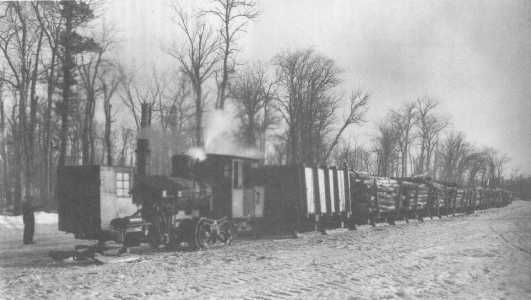
THE ARMOUR PAIL FACTORY'S STEAM HAULER OPERATING ON THE ICE ROAD SOUTH OF MISSISSIPPI LANDING
Courtesy Minnesota Historical Society
For many years, the only way the local people could cross the Mississippi River was to take the ferry down by Ball Bluff or Mississippi Junction. In 1927, the community rejoiced when the state highway department constructed a bridge at Jacobson. "Jacobson's big day has now passed into history, but no one in that vicinity is going to forget August 25, 1927, as long as he lives. That is the day when 2,500 people in about 500 automobiles came from far and near to dedicate the Jacobson bridge across the Mississippi. It marks the opening of a new era for that locality, when the antiquated ferry became a thing of the past and the bridge opened an avenue into a far brighter future." (Hill City News ~ Sept 1, 1927)
While the first "company school" was built at Mississippi Landing in 1893, the other schools didn't come for a number of years later. The West Jacobson school was built in the early 1920's and was closed down in the 1930's. The East School was built around 1927. It appears the school board kept the Mississippi Landing School open for a few years after the East School was built. The reason the East School wasn't put nearer to town was because the ground was not firm enough to handle a large structure. (Per interview with Robert Lundin on 1/22/1990) One old time settler from the area related how significant the year 1927 was for the region's people. "I always said that 1927 was the most important year for Jacobson. That was the year that the co-op store, the East School, the Presbyterian Church, and the bridge were built, and I was born." (Per interview with Walter Koski on 5/18/1990)
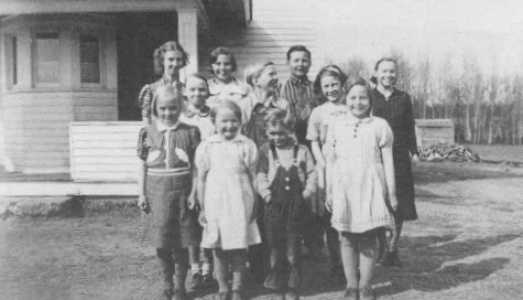
WEST JACOBSON SCHOOL IN 1938
Front three children L to R: Lillian Koski, Clarice Jackson, Stanley Nuorala
Back L to R: Teacher Gudron Johnson, Aili Suoja, Aili Koski, Walter Koski, Walter Jaakola, Betty Hagman, Beverly Jackson, Lillian Suoja
Courtesy Walter Koski
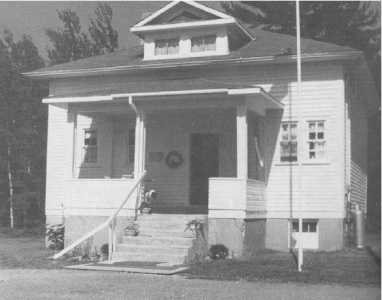
EAST JACOBSON SCHOOL IN 1988
Leo Trunt Collection
While construction of the Jacobson Presbyterian Church began in 1927, the building wasn't completed until 1928. It was the first church in the area and proved to be a positive influence for the town and a real community center. (Hill City News ~ Nov. 1, 1928) The church was a product of the "sky pilots" or preachers of the timber lands.
This was a time of expansion for the Jacobson community. During the 1920's, there were as many as four businesses in operation. There was the Mississippi Mercantile, the Jacobson Mercantile, the Ninian Westerlund Store, and the Jake Thoe Gas Station and Tavern. (Per interview with Walter Koski on 56/18/1990)
On June 5, 1928, the plat of Bridge Park was recorded by James and Margaret McDonald. This plat was successful, and the present community of Jacobson is recognized by the development in this plat.
On July 14, 1929, came the horrible news that the Hill City Woodenware Factory had caught fire and was totally destroyed. While arson was suspected, it could not be proven. (Hill City News ~ July 25, 1929)
So how did Mississippi Landing become Jacobson? It probably began when Paul Jacobson opened the first post office at Hiawatha. From that point on people referred to the area as Jacobson when they sent mail to Jacobson's Post Office. In later years, the highway department placed signs on Highway 65 that said "Jacobson" and from then on, the name was adopted by most people and is used to this day.
 THE JACOBSON POST OFFICE
THE JACOBSON POST OFFICE
by Jeanne Schram
The post office was located in at least four places over those years. The Postal Service did not own the buildings. Some of the buildings were leased and others were in the postmasters' homes. The current post office building is owned by Sidney Saari, whose home is across the road.
Postmasters who served in Jacobson were: Paul Jacobson, 1901; August McDonald, 1906; Robert Greenwood, 1913; Harriet Culver, 1918; Julia Simons, 1920; Viola Johnson, 1923; (she served there the longest with 27 years); Geraldine Kleven, 1950; James Kleven, 1965; Katherine Melquist, 1971; and Anita Kurtock, 1985.
 Mississippi Presbyterian Church still serves after 78 years
Mississippi Presbyterian Church still serves after 78 years
Jacobson Church Emphasizes Community
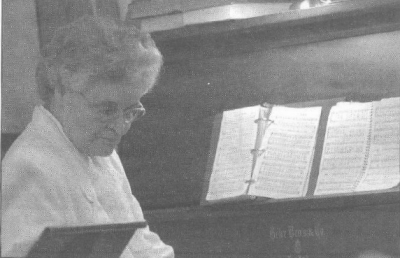
Preparing to worship: Dolores Hughes plays the piano at the Jacobson Community Church.
She has been playing now for 12 years.
Prior to that she played at the Full Gospel in Grand Rapids.
Photo by John Gronea/Voyageur Press of McGregor
Contributed by Karen Klennert
 NEXT
NEXT
BACK
HOME
|





